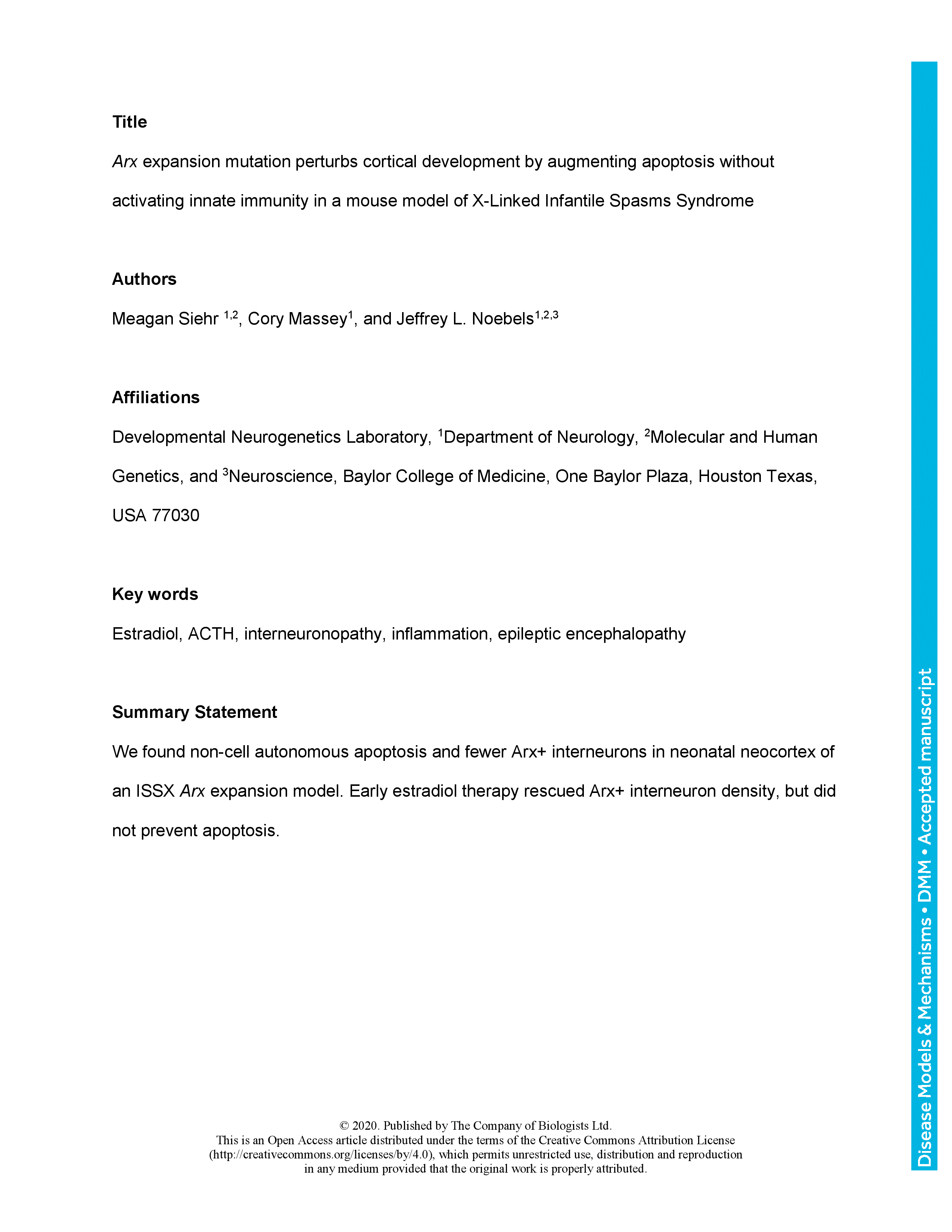X-linked infantile spasms (ISSX) is a clinically devastating developmental epileptic encephalopathy with life-long impact. Arx(GCG)10+7, a mouse model of the most common triplet-repeat expansion mutation of ARX, exhibits neonatal spasms, electrographic phenotypes, and abnormal migration of GABAergic interneuron subtypes. Neonatal presymptomatic treatment with 17β-Estradiol (E2) in Arx(GCG)10+7 reduces spasms and modifies progression of epilepsy. Cortical pathology during this period, a crucial point for clinical intervention in ISSX has largely been unexplored, and the pathogenic cellular defects that are targeted by early interventions are unknown. In the first postnatal week, we identified a transient wave of elevated apoptosis in Arx(GCG)10+7 mouse cortex that is non-Arx cell autonomous, since mutant Arx-immunoreactive (Arx+) cells are not preferentially impacted by cell death. NeuN+ survival was also not impacted suggesting a vulnerable subpopulation in the immature Arx(GCG)10+7 cortex. Inflammatory processes during this period might explain this transient elevation in apoptosis, however, transcriptomic and immunohistochemical profiling of several markers of inflammation revealed no innate immune activation in Arx(GCG)10+7 cortex. Neither neonatal E2 hormone therapy, nor ACTH(1-24), the frontline clinical therapy for ISSX, diminished the augmented apoptosis in Arx(GCG)10+7, but both rescued neocortical Arx+ cell density. Since early E2 treatment effectively prevents seizures in this model, enhanced apoptosis does not solely account for the seizure phenotype, but may contribute to other aberrant brain function in ISSX. However since both hormone therapies, E2 and ACTH(1-24), elevate the density of cortical Arx+-interneurons, their early therapeutic role in other neurological disorders hallmarked by interneuronopathy should be explored.
Arx expansion mutation perturbs cortical development by augmenting apoptosis without activating innate immunity in a mouse model of X-Linked Infantile Spasms Syndrome
Currently Viewing Accepted Manuscript - Newer Version Available
Meagan Siehr, Cory Massey, Jeffrey L. Noebels; Arx expansion mutation perturbs cortical development by augmenting apoptosis without activating innate immunity in a mouse model of X-Linked Infantile Spasms Syndrome. Dis Model Mech 2020; dmm.042515. doi: https://doi.org/10.1242/dmm.042515
Download citation file:
Advertisement
Sex matters in preclinical research

DMM calls for improved inclusion, analysis and reporting of sex as a biological variable in preclinical animal modelling research. Read the full Editorial by Monica J. Justice.
Subject collection: Building advocacy into research

DMM’s new series - Building advocacy into research - features interviews, ‘The Patient’s Voice’, with patients and advocates for a range of disease types, with the aim of supporting the highest quality research for the benefit of all patients affected by disease.
Travelling Fellowships for early-career researchers

DMM and its sister journals offer Travelling Fellowships of up to £3,000 to graduate students and post-doctoral researchers wishing to make collaborative visits to other laboratories. Find out more about our Travelling Fellowships and read stories from previous grant recipients.
Read & Publish Open Access publishing: what authors say

We have had great feedback from authors who have benefitted from our Read & Publish agreement with their institution and have been able to publish Open Access with us without paying an APC. Read what they had to say.
The Forest of Biologists
Our Publisher Claire Moulton recently visited the two Woodland Trust UK sites where we are planting new native trees for published Research and Review papers and protecting ancient woodland on behalf of our peer reviewers.
Other journals from
The Company of Biologists



